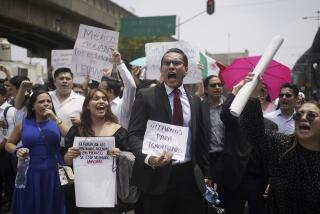Obama calls for new restrictions on biggest banks
- Share via
Reporting from Los Angeles and Washington Walter Hamilton -- Culminating weeks of increasingly angry words and bolder action aimed at Wall Street, President Obama proposed the toughest new restrictions yet on the nation’s largest banks in the aftermath of the financial crisis.
The plan would reconstruct a barrier similar to one erected during the Great Depression, but repealed in 1999, to limit the risks that banks could take with federally insured deposits. Obama also wants to broaden restrictions on the growth of large banks so none would have too big a role in the U.S. financial system.
It’s too early to know whether the proposal can win congressional approval, but its unveiling Thursday helped send the Dow Jones industrial average plunging 213 points, or 2%, the biggest decline since last fall.
More than any other proposal, Obama’s latest effort could take a big bite out of the bottom lines of such major Wall Street firms as JPMorgan Chase & Co., Bank of America Corp., Citigroup Inc. and Goldman Sachs Group Inc., whose shares each lost at least 4% of their value Thursday.
“There’s a concern that this is a sign the administration has decided to become populist and hit the banks hard,” said former investment banker Douglas Elliott, now an economics fellow at the Brookings Institution. “So even if this particular thing doesn’t get implemented, is it a sign that there will be additional attacks to come?”
Obama’s proposal would bar financial institutions with commercial bank units from owning or investing in securities operations that benefit only themselves and would slap caps on the amount of deposits and other liabilities they could hold.
“We simply cannot accept a system in which hedge funds or private equity firms inside banks can place huge, risky bets that are subsidized by taxpayers and that could pose a conflict of interest,” Obama said Thursday in a brief White House speech, flanked by his top economic advisors and key congressional leaders.
“And we cannot accept a system in which shareholders make money on these operations if a bank wins but taxpayers foot the bill if a bank loses,” he said.
Though some Republicans support the concept of such restrictions, others slammed it.
“This renewed focus on financial services reform by the Obama administration is clearly a transparent attempt at faux populism, in light of the outcome of the Massachusetts Senate race,” said Rep. Scott Garrett (R-N.J.), referring to the Democrats’ embarrassing loss Tuesday in the race to fill the seat left vacant by the death of Sen. Edward M. Kennedy.
“The American people have rejected extreme government expansion into the private sector, be it in the healthcare, financial services or auto industry,” Garrett said.
The proposal is a revised version of the Glass-Steagall Act, enacted after the market crash that triggered the Great Depression. That law separated commercial banks and investment banks.
In repealing those restrictions 11 years ago, Congress opened an era in which bank holding companies could own not only institutions that accepted customer deposits but also Wall Street investment firms. That allowed Bank of America, for instance, to acquire a faltering Merrill Lynch & Co.
Obama contended that commercial banks today have an unfair advantage over other investment firms because the government helps insure their deposits and the Federal Reserve gives them access to low-interest loans through its discount window.
Under his proposal, commercial banks still would be allowed to own investment banks, but they would have to adhere to new limitations designed to reduce the risk to depositors.
Banks with federally insured deposits would be prohibited from owning or investing in hedge funds or private equity funds. And they would not be able to use funds to trade on their own behalf, a practice known as proprietary trading. They would still be able to trade securities on behalf of their customers.
Proprietary trading is a small but important activity at many Wall Street banks, which see it as a promising area of growth in coming years if other lines of business lag in a slow-growing economy. Goldman is Wall Street’s biggest “prop” trader, and the company’s finance chief estimated Thursday that it accounts for 10% of the company’s revenue.
Given the murky nature of prop trading, Wall Street could navigate around any new limits, some analysts said.
“It’s significant, however it’s not devastating,” said Tom Brown, head of Second Curve Capital in New York.
Some leading economists, led by former Federal Reserve Chairman Paul Volcker, one of Obama’s advisors, have been calling for months for a revised version of the Depression-era restrictions.
Obama did not include the restrictions in the comprehensive financial regulatory overhaul he proposed last summer. And the administration did not propose the changes even as the House last fall completed its version of the legislation, which gives regulators the ability to prohibit proprietary trading at financial firms whose failure could pose a risk to the economy.
But beginning with his description last month of Wall Street executives as “fat-cat bankers,” Obama has been focusing more fire on large financial institutions. JPMorgan, Goldman and others have returned to big profits even as average Americans continue to struggle and unemployment remains at 10% nationwide.
Last week, Obama proposed a new tax on the 50 largest financial institutions to recoup projected losses in the $700-billion bailout fund.
The latest restrictions were designed over recent weeks, administration officials said, with input from Volcker, prompting Obama to refer to them as “the Volcker rule.”
Large financial firms opposed the administration plan, and one trade group called it counterproductive.
But Bank of America said in a statement that it already had ended or reduced many of its high-risk activities, such as issuing certain derivatives and making “private equity investments that are not part of a client-banking relationship.”
“We will look carefully at this proposal when its details become available,” the Charlotte, N.C., bank said.
Obama’s plan also would seek to limit the future growth of large institutions, adding to an existing prohibition on any firm holding more than 10% of the insured bank deposits in the nation.
The administration wants regulators to impose a new cap on a firm’s liabilities other than deposits. The specifics of such a cap would have to be worked out by regulators, but administration officials said the terms were not designed to reduce the market share of any existing firm, but rather “to constrain future growth that leads to excessive concentration.”
Goldman and Morgan Stanley could avoid any added regulations. They were conventional investment banks until they sought bank charters amid the crisis in late 2008 to protect themselves from the market turmoil. Should the new rules be enacted, those companies could decide they don’t need the complications and give up their bank status.
Other banks, such as JPMorgan Chase and Bank of America, that have large traditional banking operations, would find such a move difficult.
The prospects for Congress passing Obama’s newest proposals are unclear.
House Financial Services Committee Chairman Barney Frank (D-Mass.) told CNBC he supported the plan but that it probably would be phased in over three to five years.
Bills introduced last month in the House and the Senate would restore the Glass-Steagall restrictions. The Senate bill was co-sponsored by Sens. Maria Cantwell (D-Wash.) and John McCain (R-Ariz.), indicating some bipartisan support for the concept.
jim.puzzanghera @latimes.com
Times staff writer E. Scott Reckard contributed to this report.
More to Read
Inside the business of entertainment
The Wide Shot brings you news, analysis and insights on everything from streaming wars to production — and what it all means for the future.
You may occasionally receive promotional content from the Los Angeles Times.











